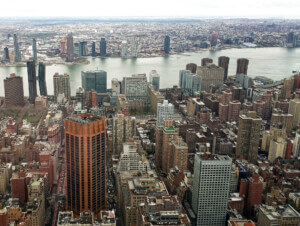Michael Friedlander, a Cooper Union-educated architect whose 40-year career with the New York City Department of Sanitation (DSNY) yielded workaday municipal structures like garbage truck garages and road salt storage sheds that were playful, beautiful, and neighborhood-bettering when they easily didn’t need to be, has died. As noted in his New York Times obituary, Friedlander, a lifelong New Yorker raised in the East Village, passed away on March 21 from complications of an infection. He was 63.
Colleagues and contemporaries have taken to social media to pay tribute to Friedlander since news of his death became public. They include former DSNY commissioner Kathryn Garcia, architect James Timberlake, and Claire Weisz, principal of WXY architecture + urban design, who stated: “Michael Friedlander was tenacious in creating and supporting a voice for architecture as critical to DSNY.”
Friedlander—acting as in-house architect for the DSNY— and WXY along with Dattner Architects, former City Planning Commission chair Amanda M. Burden, and James S. Polshek of the New York City Public Design Commission (PDC), are credited by the NYT as being among the “many mothers and fathers” responsible for conceiving the Spring Street Salt Shed, a sculptural DSNY storehouse completed in 2015 along Manhattan’s West Side Highway that’s crystalline form serves as a monumentally cheeky giveaway as to the contents inside. Per the Times, Friedlander himself referred to the $20 million building as an “architectural folly.”
Despite fierce initial opposition to the Spring Street Salt Shed and the DSNY’s adjacent garbage truck garage by celebrity-filled local community groups, the singular project won over naysayers at its completion and quickly became the heavily-feted architectural toast of the town, a utilitarian civic structure doubling, quite unexpectedly, as a local landmark. In addition to racking up myriad accolades and awards (the AIA New York Architecture Honor Award, the AIA New York State Design Award for Excellence, and the NYC Art Commission Design Award 2011 among them), the mimetic 6,300-square-foot road salt repository even played host to a major fashion show in 2016.
“The DDC [New York City Department of Design and Construction] sees every assignment as an opportunity to provide architecturally impactful, sustainable and resilient buildings,” said former DDC Commissioner Feniosky Peña-Mora at the time. “This event demonstrates how a utilitarian building can contribute to one of the most glamorous events in our city.”
In addition to the Spring Street Salt Shed and neighboring, green roof-topped DSNY garage, other lauded projects overseen by Friedlander during his long and impactful tenure at the DSNY include a visually arresting sanitation garbage that spans from 55th to 57th Street along 12th Avenue in Manhattan and a salt storage shed in Far Rockaway Queens covered in “translucent tent fabric,” as the NYT wrote in a 2007 profile of a then-50-year-old Friedlander. At the time, he had just been bestowed with a special award from the PDC (then known as the Art Commission) for “the quality of design that he consistently brings to the Department of Sanitation’s capital projects.”
“Typically, people don’t want a sanitation garage — they have a knee-jerk reaction,” Friedlander told the NYT in 2007. “But if it’s designed well, it’s not going to be objectionable. If you go a little further and really bring some care and attention to the building, it goes a long way towards adding something to the neighborhood.”











